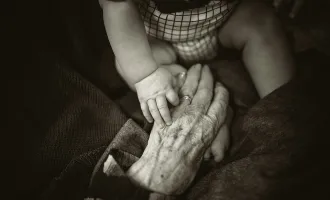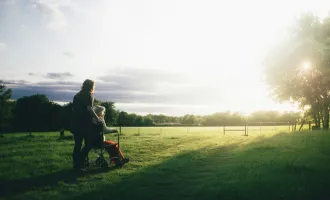My Long COVID Experience
The sun was at its highest point in the sky. At the same time, I was at my lowest point recovering from an overnight shift (which I still question the utility of for medical students, however that is for a separate piece altogether). I pulled in my blackout curtains and had them meet in the middle of my bedroom window frame.
The window would remain open as my non-air-conditioned apartment was a sauna during the day. I laid down, and as my top eyelid met the bottom one, I attempted to gather some rest. I tossed and turned for what seemed an eternity but finally found a comfortable position.
However, as I lay there, I began to feel nauseous, dizzy, confused, and could feel a blistering headache approaching.
I stumbled out of bed, fell to the ground, and my earplugs fell out. I slowly arose to considerable chatter outside and set aside my curtains only to discover a fire across the street.
The smoke had permeated my room, and I was now experiencing the early signs of carbon monoxide poisoning.
I rushed to the opposite side of my apartment, and out the door I scurried. The sheer horror of the situation made me realize two things.
First, I need to switch out the battery of my carbon monoxide monitor. Second, I was horrified I couldn’t smell any of the smoke. But why?
Nine months ago, I caught COVID-19 while the country was experiencing a summer surge via Omicron. Thankfully, I was vaccinated, and thus my course was not as severe as it could have been. Yet, it did keep me in bed for quite a few days, but thankfully, the bed in my apartment and not a bed inside a hospital’s intensive care unit (which would have been more likely if I were unvaccinated).
After experiencing the gamut of symptoms, one would expect, the most insufferable one was losing my sense of smell.
At first, it was only the most pungent of odors that eluded me, which as someone who spends much of his time within bleached hospital corridors, was something I could get used to, but soon after, all of the wonderful scents that texture my everyday life began to disappear: the zest of orange peels, the warm notes of cinnamon, the crisp aquatic mist of the ocean, and, most tragically, the mixture of turmeric, cumin, and coriander within my mother’s cooking.
And they all still elude me to this day.
I have attempted multiple tricks to regain my sense of smell, some of which I am less proud to admit than others, but I have been unable to escape this insufferable anosmic existence. What has happened?
My inability to smell is a variant of what the medical research community describes as post-acute sequela of SARS-COV2 infection (PASC), or what has become known as Long COVID.
There are varying definitions, yet a common thread includes symptoms or conditions that emerge after the acute phase of infection with SARS-COV2.
Symptoms range from mild to severely debilitating; may involve multiple organs or organ systems; and can persist for weeks, months, or years.
More commonly reported symptoms include fatigue, shortness of breath, cognitive difficulties (i.e., “brain fog”), insomnia, persistent fevers, anxiety, depression, and loss of taste or smell.
And the list seems to be expanding.
Over the past year, there has been a surge of stories of patients with Long COVID published in the news media. And these patients have ranged across the age and health spectrum, with a few coming to mind. Shelley Hayden, a 50-year-old marketing coach infected with COVID in 2020, states that the deleterious effects on her cognition make her feel her “brain is broken.”
Or, 26-year-old Olympian Onnagh Cousins, who before being infected with COVID endured a physically grueling 35-hour-per-week training regimen, now says her intense fatigue permits her to only a few hours of activity a day.
Or, 9-year-old Haley Bryson, who has suffered headaches, earaches, exhaustion, soreness in her chest and throat, and stomach problems so intense she has been seen in the emergency department multiple times. In comparison to the suffering endured by these people, I consider my case to be a mild one.
Tragically, Long COVID may have already affected up to 23 million Americans, or up to 7% of the U.S population, per the U.S Government Accountability Office. There are varying estimates of the proportion of people infected with COVID who develop Long COVID.
Still, some studies report a prevalence as high as 80% of COVID survivors, while others report 10%. Regardless, it is a significant number as COVID has infected at least 500 million people worldwide (and counting).
But what exactly is causing Long COVID in some patients? There are several leading hypotheses regarding the biological underpinnings, with the leading one speculating virus or viral remnants habituating our body tissues and triggering chronic inflammation.
Another hypothesis is autoimmunity, as the infection can induce the body to attack itself. And others believe Long COVID is likely composed of multiple disease processes that are awaiting disentanglement.
And, yet despite how serious Long COVID is, many don’t seem to consider it in their risk calculus. I have heard something in various social circles to the tune of “I’m young and healthy, I’ll be fine as it’s just a respiratory viral infection like the cold.” This later became “I’m young, healthy, and vaccinated, I’ll be fine…”
And now it has become “I’m young, healthy, vaccinated, and boosted, I’ll be fine...” In the city I live in, we have all but removed mask restrictions, vaccine card requirements, and physical distancing despite having among the highest rates of COVID infection in our state.
On a broader scale, the country is no different in that both the public and private sectors have seemed to have moved past the pandemic despite a surge in cases. Unsurprisingly, the trends of Google Searches for Long COVID symptoms tend to mirror the waves of COVID-19 cases.
Thus, each successive wave of covid that comes crashing towards us may mean more people drowning in chronic sequelae. Evidently, our short-sighted measures do not seem to take Long COVID into account. Why?
This may be attributed to a lack of awareness of Long COVID, which may change with increasing media attention. The other reason, which I believe is the more likely culprit, is misunderstanding.
We have not framed COVID as a virus that can lead to potentially chronic debilitating disease, and quite honestly, I did not view it as such until my own experience with it.
When the pandemic began, we framed COVID as a self-resolving respiratory viral illness, which for a proportion of people, it may very well be.
However, we now know it can be a multisystem viral illness with lasting sequelae, putting it in the neighborhood of similar viruses (e.g., Epstein-Barr Virus). Thus, public health messaging must characterize it as such. If the public is more informed of the potential Long-term effects of COVID, that may recalibrate our collective risk calculus and influence decision-making.
And thus, to protect more people from dealing with this chronic disease, that messaging must come soon.
Recently, the Biden Administration released a statement concerning a nationwide effort to prevent, treat, and detect Long-COVID. In this statement, there was a focus on three key areas. The first is to deliver high-quality care for individuals experiencing Long COVID. Second, to make services and support available for individuals experiencing Long COVID. And third is advancing the nation’s understanding of Long COVID.
Given the dizzying array of presentations and our nascent knowledge of this condition, clinicians in the present moment are ill-equipped. However, across the nation, scientists and public health leaders are working at a frenetic pace in these three areas hoping to provide the tools and knowledge needed to lessen enduring suffering.
Thankfully, growing evidence demonstrates vaccinated people who endure a breakthrough infection are less likely to develop Long COVID than those who are unvaccinated and become infected.
In addition to the goals above, we must reinforce the importance of vaccination to prevent serious illness from an acute COVID infection and as a preventative of developing Long COVID, particularly because vaccination rates have plateaued in this country for quite some time.
COVID has affected us all in many ways, yet some effects linger longer for those who have been infected.
With increasing attention and allocation to the issue of Long COVID, we can hopefully help patients in need of immediate help and prevent more individuals from suffering from this chronic condition.



